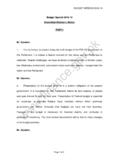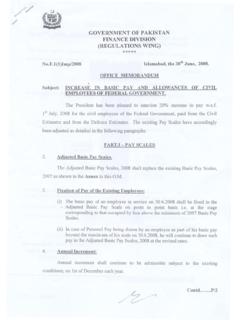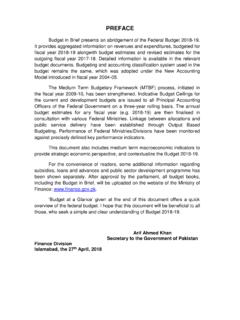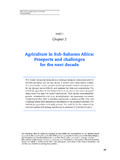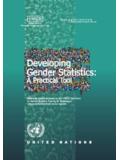Transcription of Population, Labour Force and Employment - Finance
1 chapter 12 population , Labour Force and Employment population size, growth rate, and its composition play an important role in the social and economic development of a country. Demographic statistics of a country is essential for drafting the plans, frame work of economic policies and judging the growth and development. Pakistan is among those developing countries where population growth is fairly high. At present it is the sixth most populous country in the world with projected population of 188 million. According to World population Data Sheet 2013, Pakistan with population of 363 million in 2050 is expected to retain the same position ( sixth position).The population growth rate in Pakistan is percent which is higher than average growth rate of South Asian countries. The major cause behind higher growth rate is high fertility rate.
2 Although, over time various governments have been trying to tackle the issues of high population growth rate through introducing different programmes like Family Welfare Centers (FWC), Reproductive Health Services Centers (RHS-A), Regional Training Institutes and Mobile Services Unit. However, these programmes could not achieve the desired results mainly due to low literacy level particularly among women in rural areas, cultural and religious constraints, and lack of skills in promoting family planning. It is worth mentioning that female education has a significant effect on fertility. Women having higher education have a fewer children as compared to women with less education. Therefore, each year the number of inhabitants is increasing whereas the resources available in the country are limited due to which demographic imbalance is increasing.
3 But this demographic imbalance can be improved with the help of youth population of the country. Pakistan is one of the world s largest youth bulge country with 48 percent population aged 15-49 and 56 percent (age 15-64) is in productive age group. This young and dynamic population is considered an omen of prosperity. They can contribute for the economy and society with their education and skill. With proper education and training and balanced health facilities, they can prove to be an asset of the country and can be a source of future prosperity and development of the country. Demography is the study of the growth, change and structure of the human population . The demographic indicators, therefore, are comprised of the collection of information that summarizes the historical evolution of different changes related with population .
4 Major demographic indicators are changes in the size, structure, and population composition and population growth. Changes in the size and structure of population are due to changes in the birth rate, death rate and the net migration. Table : Selected Demographic Indicators 2012 2013 2014 Total population (Million) Urban population (Million) Rural population (Million) Total Fertility Rate (TFR) Crude Birth Rate (Per thousand) Crude Death Rate (Per thousand) population Growth Rate (Percent) Life Expectancy (Year) - Females - Males Source: Ministry of Planning ,Development and Reforms ( population Projections for the Year 2007-2030) 180 Pakistan Economic Survey 2013-14 Crude Birth Rate: Crude Birth Rate (CBR) is the annual number of live births per one thousand persons.
5 CBR of more than 30 per thousand is considered high and a rate of less than 18 per thousand is considered low. The global CBR in 2013 was 20 per thousand, while the CBR in Pakistan has been marginally improved from percent in 2013 to percent in 2014. Crude Death Rate: Crude Death Rate (CDR) is defined as total death per one thousand persons in a year. CDR of less than ten per thousand is considered as low while above twenty per thousand is considered as high. The global CDR was 8 persons per one thousand in mid 2013. However, improvements in health services and expansion in medical facilities in Pakistan have led to decline in CDR from percent in 2013 to percent in 2014. These rates are often referred as crude rates because they do not take into account population age structure.
6 Life Expectancy Life expectancy is the number of years a person would be expected to live, starting from birth and it measures quantity rather than quality of life. Globally it is observed that high life expectancy is associated with high income per capita, improved nutrition, better hygiene, access to safe drinking water, effective birth control and immunization and other better medical facilities. Life expectancy in women is higher than men. Currently, the global life expectancy for both male and female is 70 years. However, while considering it gender wise, the life expectancy for males is 68 years and for females is 73 years- a difference of five years. In Pakistan, the average life expectancy has improved from in 2013 to in 2014 for males and for females it has improved from in 2013 to in 2014.
7 population Growth population growth rate is another important indicator used to describe the change in population and play a focal point in the economic development of a country. Rapid population growth can generate food security problem, environment problem and urban congestion and it is the major factor behind the international migration. In Pakistan population growth rate has shown improvement and it decreased from percent in 2012 to percent in 2013 and percent in 2014. Table: Percentage of population 2012-13 Age Group Male Female Total 0-4 5-9 10-14 15-19 20-24 25-29 30-34 35-39 40-44
8 45-49 50-54 55-59 60-64 65 and above Total 100 Source: Pakistan Labour Force survey 2012-13 Age Composition of population Age composition of population refers to distribution of population by age and sex. The data on population by age and sex is vital for demographers, health administrators and other policy makers etc. for planning and execution of various health development programmes. The organization of population by rural/urban, sex and marital status and age unveils the features of population composition and provides disaggregated data for target oriented analysis.
9 1551601651701751801851900510152025302008 200920102011201220132014 Crude Birth & Death RateSource: Ministry of Planning ,Development and : population OverviewCrude birth rateCrude death ratePopulation (mln) population , Labour Force and Employment 181 Age composition of population is important for several reasons. The estimates of proportion of children and older persons is important for the provision of national expenditures on schools , childcare, immunization and reproductive health services vis-a vis expenditure on old age social security systems and health care for chronic and degenerative diseases. Table presents the age structure of the population of 2012-13. Table shows that 41 percent population is in the age group of 0-14 and this group is economically unproductive and need food, clothing, education and medical care.
10 They depend upon working population for their necessities. Adult population is considered as wealth of a nation in terms of human resource. This Table shows that 56 percent population is in the age group of productive age population is the main source to ensure accelerated economic growth. Policy makers may take advantage of this growing working class in reducing dependency burden in the future. For making the strategies to reduce poverty level and tapping their potential into productive economic activities, policy makers may focus on the provision of livelihood earning skills through short term vocational training aimed at provision of employable skills. population by Martial Status Marital status is defined as the personal status of each individual in relation to the marriage laws or customs of the country.




